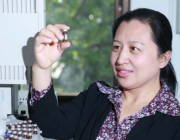摘要:
Both organic carbon (OC) and elemental carbon (EC) were measured during PRIDE-PRD 2006 summer campaign by using a semi-continuous thermal-optical carbon analyzer at a rural site, Back Garden (BG), which is located 50 km to the northwest of Guangzhou City. Together with the online EC/OC analyzer, various kinds of instruments related to aerosol chemical properties were employed here, which provided a good opportunity to check data quality. The concentrations of OC correlated well with the mass of organic matter (OM) and water soluble organic carbon (WSOC), implying the reliability of the data measured in this campaign. The average OC concentrations in fine particle for three typical periods during the campaign (local emission influence, typhoon and precipitation and normal days) were 28.1 mu gC m(-3), 4.0 mu gC m(-3) and 5.7 mu gC m(-3), respectively; and EC were 11.6 mu gC m(-3), 1.8 mu gC m(-3), and 3.3 mu gC m(-3), respectively. The diurnal patterns of EC and OC during the campaign were higher at night and in early morning than daytime, which was probably caused by the primary emission and accumulation in the occurrence of low boundary layer. Compared with the constant diurnal enhancement ratios of EC, the enhancement ratio of OC (OC versus (CO-CObackground)) kept in a relative high level in the afternoon, with a similar diurnal profile to oxygenated organic aerosol (OOA), due to the strong photochemical formation of OC. Here, a modified EC tracer method was used to estimate the formation of secondary organic carbon (SOC). These results showed that the average SOC concentration (normal days) at BG site was about 2.0 +/- 2.3 mu gC m(-3), and the SOC fraction in OC could reach up to 80% with the average of 47 %. The modified approach in this study proved to be effective and reliable for SOC estimation based on good correlations between estimated SOC versus OOA or WSOC, and estimated POC versus hydrocarbon-like organic aerosol (HOA).附注:
900GWTimes Cited:0Cited References Count:41